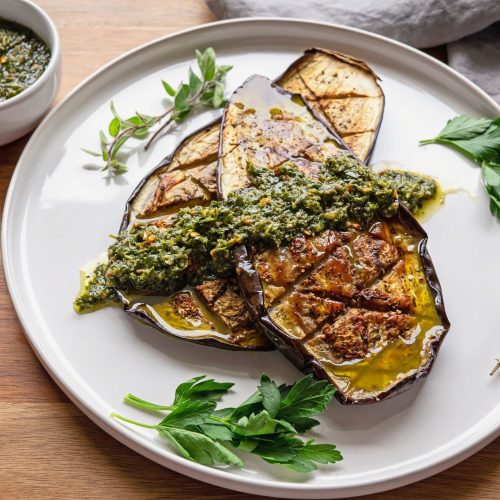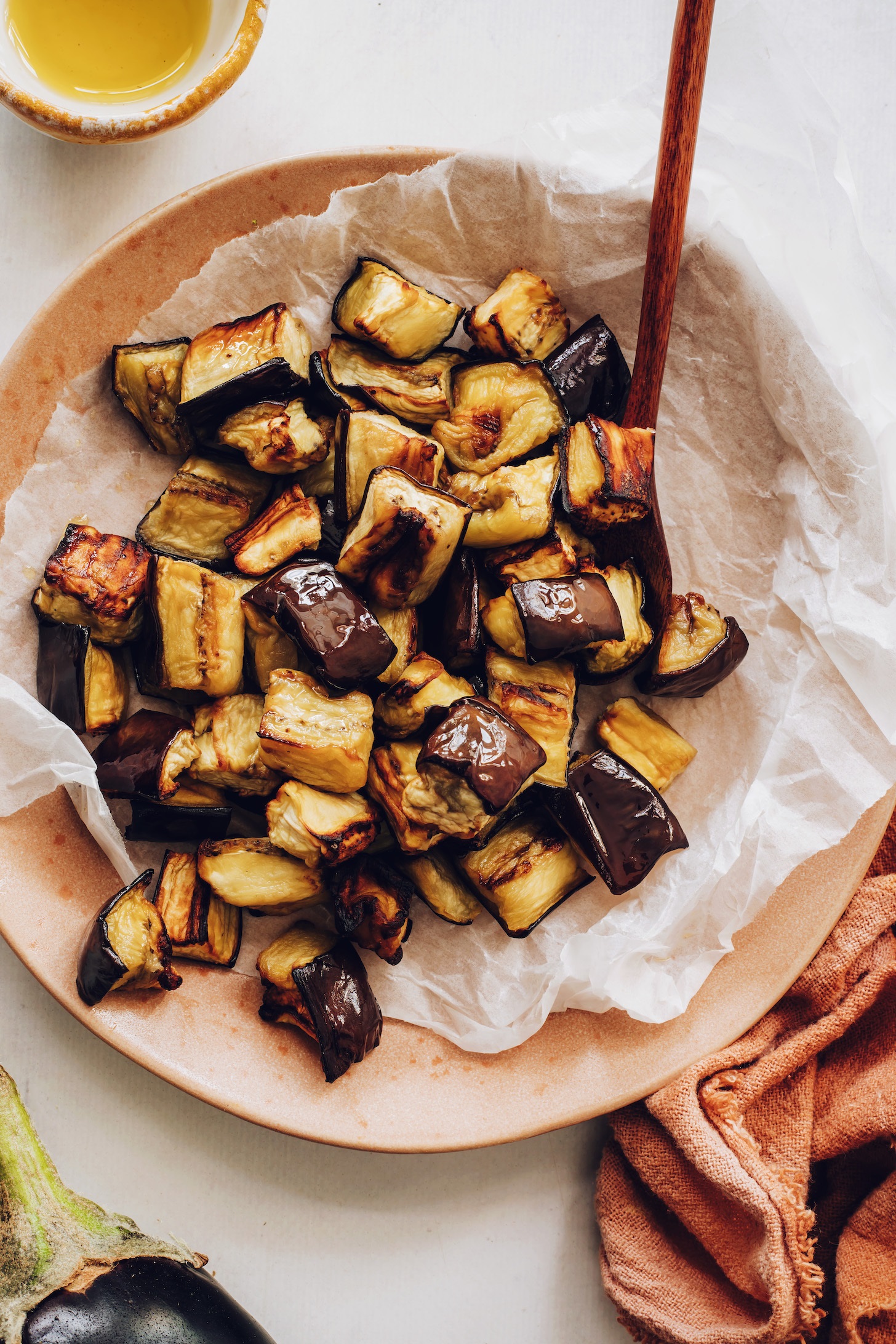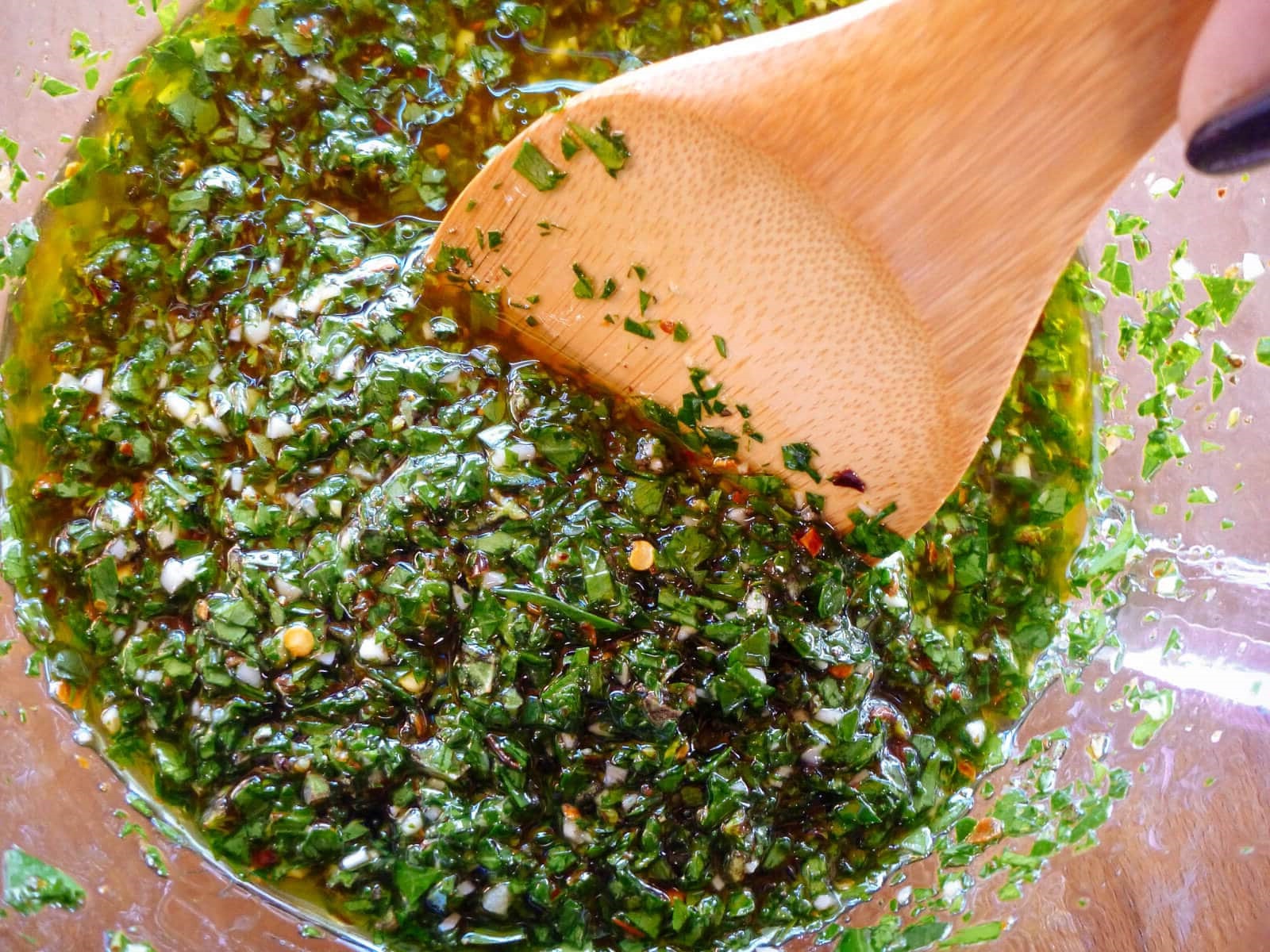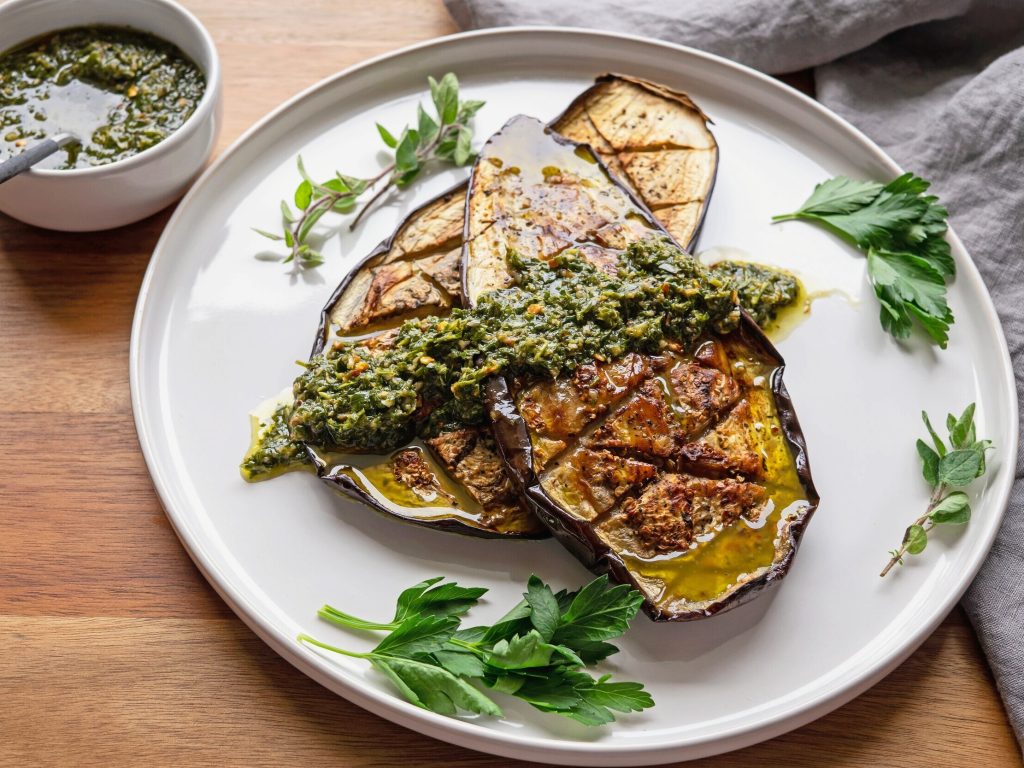
Roasted Eggplant with Chimichurri Recipe
Equipment
- Baking sheet
- Knife
- Cutting board
- Mixing bowl
- Food processor or blender (optional)
Ingredients
- 1 large globe eggplant
- Salt for salting the eggplant
- Olive oil for roasting and the chimichurri
- 1 cup fresh parsley leaves only
- 1/2 cup fresh cilantro leaves only
- 1/4 cup fresh oregano leaves only
- 3 cloves garlic peeled
- 1/4 cup red onion roughly chopped
- 1/2 teaspoon red pepper flakes
- 1/4 cup red wine vinegar
- 3 tablespoons fresh lemon juice
- 1 teaspoon kosher salt
- Freshly ground black pepper to taste
Instructions
- Preheat oven to 400°F (200°C).
- Wash and slice the eggplant into 1/2-inch thick rounds. Salt the slices and let them sit for 15 minutes.
- Pat the eggplant dry with a paper towel.
- Arrange the slices on a baking sheet and drizzle with olive oil.
- Roast for 20-30 minutes, or until tender and golden brown.
- While the eggplant roasts, make the chimichurri. Finely chop the herbs, garlic, and red onion (or use a food processor).
- Combine the chopped ingredients in a bowl with red pepper flakes, red wine vinegar, lemon juice, olive oil, salt, and pepper.
- Taste and adjust seasonings as needed.
- Once the eggplant is roasted, toss it with the chimichurri sauce or serve it alongside.
Notes
- You can customize the chimichurri by adjusting the herb ratios or adding other ingredients like chopped capers or a pinch of cumin.
- The chimichurri can be made ahead of time and stored in the refrigerator for up to a week.
- Serve the roasted eggplant with chimichurri warm or at room temperature.
When it comes to vegetables that shine after roasting, eggplant is at the top of my list. Roasted eggplant is tender, smoky, and has just the right amount of bite. When topped with a bright, garlicky chimichurri sauce, this humble veggie transforms into something truly special. If you’ve ever been hesitant about cooking eggplant, this recipe will change your mind, trust me.
Why Eggplant is Perfect for Roasting
Eggplant has long been a divisive vegetable. It’s the one you either love or avoid at all costs, often due to its bad reputation for being bitter or mushy. Growing up, I rarely touched eggplant because I wasn’t sure how to cook it properly. But once I learned how roasting can enhance its natural sweetness and create that perfect balance of soft flesh and crispy edges, it became a regular in my kitchen.
Roasting brings out eggplant’s best qualities. The high heat caramelizes the sugars in the flesh, giving it a sweet, smoky flavor. The skin becomes soft and easy to eat, and the inside turns perfectly tender without getting mushy. Add a zesty chimichurri sauce, and you’ve got a dish that’s both simple and packed with flavor.
Choosing the Right Eggplant for Roasting
Not all eggplants are created equal when it comes to roasting. There are several varieties you can choose from, but here are my top picks:
- Globe eggplant: The classic variety you’ll find in most grocery stores. These are large, meaty, and have a thick skin that holds up well during roasting.
- Japanese eggplant: These long, skinny eggplants have a more delicate flavor and thinner skin, making them perfect for a lighter, quicker roast.
- Indian eggplant: Small, round, and tender. These have a naturally sweet taste and roast up beautifully, becoming creamy on the inside.
Personally, I love using globe eggplants when I want something hearty and filling. When I’m looking for a quicker cook time or a lighter dish, I’ll grab the more delicate Japanese or Indian varieties.
Preparing Eggplant for Roasting
One of the great things about roasting eggplant is how easy it is to prepare. Unlike some traditional eggplant recipes that require salting and draining, roasting skips that extra step. Instead, the moisture in the eggplant helps it retain its soft, tender texture.
Here’s how to prep:
- Leave the skin on. Eggplant’s skin acts like a natural casing, holding the flesh together as it roasts. It softens beautifully in the oven and slices easily once cooked.
- Cut into thick slices. To get the perfect texture, cut the eggplant into uniform ½ inch slices. This prevents uneven cooking and ensures every slice is roasted to perfection—crispy on the outside and tender inside.
How to Roast Eggplant
Roasting eggplant is a simple process that lets the vegetable’s natural flavors shine.
- Preheat your oven to 400-425°F. You want a hot oven to ensure the eggplant gets that delicious caramelization.
- Brush the slices lightly with olive oil on both sides. This helps the eggplant crisp up and prevents it from sticking to the baking sheet.
- Season with salt and pepper. A simple seasoning allows the eggplant’s natural sweetness to come through.
- Roast for 20-30 minutes, flipping halfway. You’ll know the eggplant is ready when it’s golden brown and the edges have a nice, crispy finish.
Tip: Don’t overcrowd the baking sheet. Give the slices space to roast evenly.

Making Chimichurri
Now, let’s talk about chimichurri—this tangy, garlicky sauce is the star that elevates the roasted eggplant. Chimichurri is traditionally used on grilled meats, but trust me, it’s just as magical on vegetables.
Here’s what you’ll need:
- Fresh parsley
- Cilantro (optional, but I love the extra brightness it adds)
- Garlic
- Olive oil
- Red wine vinegar
- Lemon juice
- Red pepper flakes (for a little heat)
Simply chop the parsley and cilantro finely, mince the garlic, and mix everything together with the olive oil, vinegar, lemon juice, and a pinch of salt. The result is a zesty, herbaceous sauce that adds freshness and zing to the roasted eggplant.

Serving Suggestions
Once the eggplant is roasted to perfection, drizzle the chimichurri generously over the warm slices. The sauce not only adds a burst of flavor but also helps rehydrate the eggplant, making it even more tender and juicy.
I love serving roasted eggplant with chimichurri as a side dish to grilled chicken or fish, but it also works as the main event. Pair it with lemon-flavored rice or quinoa for a light yet satisfying meal. You can even chop the roasted eggplant and toss it into grain bowls or salads. Leftovers? Chop them up, mix with more chimichurri, and turn it into a dip for pita or veggies.
Tips for the Best Roasted Eggplant
- Don’t skimp on the oil: Eggplant is like a sponge—it absorbs oil, so make sure you brush enough on to prevent drying out.
- Let the eggplant rest after roasting: This allows the slices to soften even more and gives you a chance to prepare the chimichurri.
- Experiment with toppings: A sprinkle of feta or roasted pine nuts can add an extra layer of texture and flavor.
Conclusion
Roasting is one of the easiest ways to bring out the best in eggplant, and when paired with a vibrant chimichurri sauce, it’s a dish that’s both simple and full of flavor. Whether you’re an eggplant enthusiast or trying it for the first time, this recipe is a must-try. So fire up your oven, whip up some chimichurri, and enjoy the magic of roasted eggplant!

Hello, I’m Elaria Jackson, the author behind Vegan Castle. I have a background in Nutrition Science and Culinary Arts. I’ve studied the benefits of a plant-based diet and its impact on health and the environment. I’ve attended various vegan cooking courses and workshops. Through Vegan Castle, I share easy weeknight meals and decadent desserts. I aim to be a valuable companion on your vegan journey.

